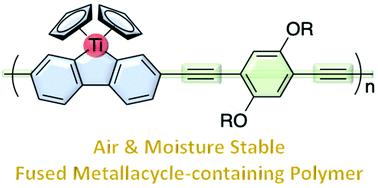An air-stable organometallic polymer containing titanafluorene moieties obtained by the Sonogashira–Hagihara cross-coupling polycondensation†
Abstract
The synthesis of a polymer containing alternating titanafluorene and arylene ethynylene moieties is described. The polymerization of a 2,7-dibromo-9-titanafluorene derivative with 1,4-dioctyloxy-2,5-diethynylbenzene is carried out at 70 °C for 48 h in tetrahydrofuran (THF) in the presence of palladium dichloride/4,5-bis(diphenylphosphino)-9,9-dimethylxanthene as a catalyst and diisopropylamine as a base to produce a dark red polymer. The polymer thus obtained is soluble in organic solvents and stable towards both air and moisture. In the UV-vis absorption spectrum of the polymer, the absorption maxima (λmax) are observed at 321 nm and 395 nm, which are bathochromically shifted compared to those of a model compound of the repeating unit, a 2,7-bis(phenylethynyl)titanafluorene derivative (λmax = 309 nm and 364 nm). The optical band gap (Eg) of the polymer is estimated to be 2.8 eV on the basis of the absorption onset, which is narrower than that of the model compound (3.1 eV).



 Please wait while we load your content...
Please wait while we load your content...